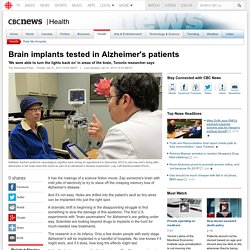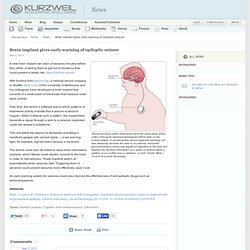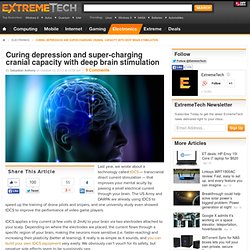

Deep brain stimulation: MedlinePlus Medical Encyclopedia. Deep brain stimulation (DBS) is a surgical treatment in which a device called a neurostimulator delivers tiny electrical signals to the areas of the brain that control movement.

Description The DBS system consists of three parts: A thin, insulated wire called a lead, or electrode that is placed into the brain The neurostimulator, similar to a heart pacemaker, which is usually placed under the skin near the collarbone, but may be placed elsewhere in the body Another thin, insulated wire called an extension that connects the lead to the neurostimulator DBS requires surgery to correctly place each part of the neurostimulator system.
DBS in adults usually involves two separate surgeries. Stage 1 is usually performed under local anesthesia, meaning you are awake but pain-free. Your head is placed in a special frame using screws to keep it still during the procedure. Stage 2 is done under general anesthesia, meaning you are asleep and pain-free. Why the Procedure is Performed Risks References. Brain implants tested in Alzheimer's patients - World. It has the makings of a science fiction movie: Zap someone's brain with mild jolts of electricity to try to stave off the creeping memory loss of Alzheimer's disease.

And it's not easy. Holes are drilled into the patient's skull so tiny wires can be implanted into just the right spot. A dramatic shift is beginning in the disappointing struggle to find something to slow the damage of this epidemic: The first U.S. experiments with "brain pacemakers" for Alzheimer's are getting under way. Scientists are looking beyond drugs to implants in the hunt for much-needed new treatments. The research is in its infancy. Kathy Sanford was among the first to sign up. Then doctors at Ohio State University explained the hope — that constant electrical stimulation of brain circuits involved in memory and thinking might keep those neural networks active for longer, essentially bypassing some of dementia's damage.
Sanford decided it was worth a shot. Her father is blunter. "What's our choice? But wait a minute. Brain & Obesity: Neural Implant Could Curb Overeating, Mouse Study Suggests. By: Denise Chow, LiveScience Staff Writer Published: 04/26/2013 09:18 AM EDT on LiveScience The brain may not seem like an obvious place to look for possible treatments for obesity, but researchers say implanting a device that stimulates a specific region of the brain may help curb the compulsion to overeat.

The new study on obese mice found that deep brain stimulation (DBS), which involves implanting a device that sends electrical impulses to precise targets in the brain, may reduce binge eating and other obesity-related behaviors. "Once replicated in human clinical trials, DBS could rapidly become a treatment for people with obesity due to the extensive groundwork already established in other disease areas," lead author Casey Halpern, a resident in the department of neurosurgery at the University of Pennsylvania's Perelman School of Medicine, said in a statement. [8 Reasons Our Waistlines Are Expanding] Brain implant gives early warning of epileptic seizure. Seizure advisory system intracranial electrode arrays (gray areas) collect intracranial electroencephalogram (EEG) data on the cortical surface.

A subclavicularly placed implanted telemetry unit then wirelessly transmits the data to an external, hand-held personal advisory device that applies an algorithm to the data and displays the resultant information as a series of advisory lights in addition to an audible tone or vibration, or both. (Credit: Mark J Cook et al. /Lancet Neurology) A new brain implant can warn of seizures minutes before they strike, enabling them to get out of situations that could present a safety risk, New Scientist reports. With funding from NeuroVista, a medical device company in Seattle, Mark Cook of the University of Melbourne and his colleagues have developed a brain implant that consists of a small patch of electrodes that measure brain wave activity. A Case of Mania following Deep Brain Stimulation for Obsessive Compulsive Disorder.
Curing depression and super-charging cranial capacity with deep brain stimulation. Last year, we wrote about a technology called tDCS — transcranial direct current stimulation — that improves your mental acuity by passing a small electrical current through your brain.

The US Army and DARPA are already using tDCS to speed up the training of drone pilots and snipers, and one university study even showed tDCS to improve the performance of video game players. tDCS applies a tiny current (a few volts @ 2mA) to your brain via two electrodes attached to your scalp. Depending on where the electrodes are placed, the current flows through a specific region of your brain, making the neurons more sensitive (i.e. faster-reacting) and increasing their plasticity (better at learning). It really is as simple as it sounds, and you can build your own tDCS equipment very easily. We obviously can’t vouch for its safety, but negative side effects seem to be surprisingly rare.